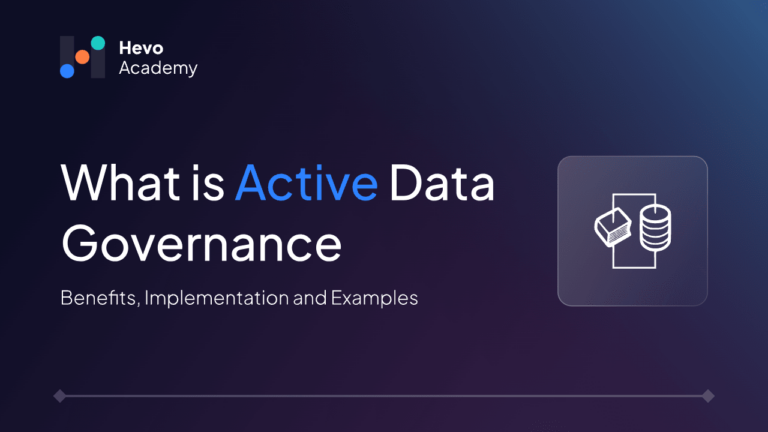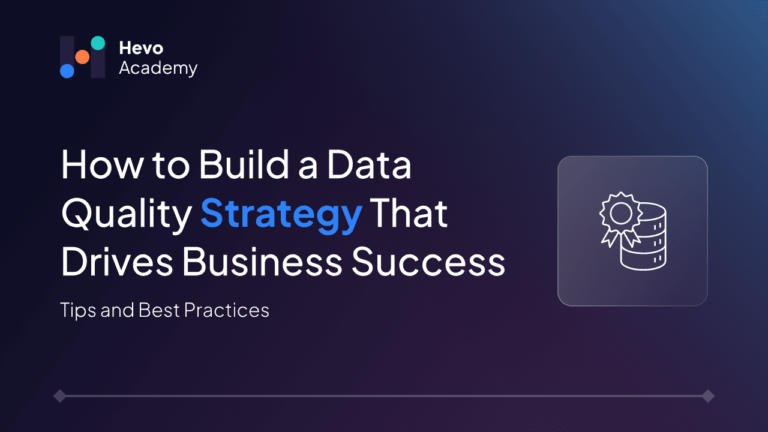Consider a city without traffic laws. Then, what do you expect? Every intersection will be chaotic, people will be in danger, accidents will happen often, and getting to destination will take a long time. Imagine that your company’s data is that city. Without good governance, data becomes a liability. Interestingly, Experian revealed that over 90% of companies have data quality issues. Active data governance can organize this mess. A dynamic data management methodology ensures your organization’s data drives innovation.
Table of Contents
Data drives strategy, innovation, and decision-making, not just corporate operations. Lack of governance prevents many organizations from reaching their full potential. Active data governance, on the other hand, emphasizes proactivity, helping firms avoid problems.
We will discuss active data governance, its importance, and its benefits to your organization. This article explains why active data governance optimizes data potential.
What is Active Data Governance?
Active data governance is a proactive and scalable approach to keep your data safe, protect its privacy, keep it accurate, and encourage everyone to use data. Traditional governance methods tend to focus on reactive actions like audits and compliance checks. On the contrary, active data governance places greater focus on continuous automation, monitoring, and teamwork.
At its core, it is about transforming data governance from a static set of rules into a living, breathing part of an organization’s operations. It ensures that data is correct, safe, and instantly available, allowing businesses to adapt quickly to changing business needs.
Key Components
- Automation: Utilizing tools to make data processes more efficient and make sure they are consistent. Automation reduces the burden of manual processes, allowing teams to focus on strategic tasks.
- Real-Time Monitoring: Continuously track data quality and security. Businesses may address problems as they arise and minimize delays by using real-time views.
- Collaboration: Involving stakeholders across departments to align data goals. Collaboration creates a sense of shared responsibility, keeping data governance from being ignored and neglected.
- Actionable Policies: Establishing clear, enforceable guidelines for data usage. Policies must be practical and adaptable to the organization’s evolving needs.
In short, active data governance ensures that data is always reliable, accessible, and secure, empowering businesses to make informed decisions. Managing data as a strategic tool is not a one-time thing; it needs to be done all the time.
What is the Need for Active Data Governance?
The modern data landscape is getting more and more complicated, which is why we need active data governance. We need to look more closely at the main reasons why businesses need to use this approach:
1. Staggering Data Growth
Now businesses get huge amounts of data from many different places, like Internet of Things (IoT) devices, social media, and contacts with customers. Data can easily become overwhelming to manage without active governance. IDC says that by 2025, the amount of data in the world will have grown to 175 zettabytes. This is an unbelievable amount of data that needs strong governance systems to be handled properly.
2. Compliance Requirements
Regulations like GDPR, CCPA and HIPAA require strict privacy protections for data. If you don’t follow the rules, you could face big fines and damage to your reputation. Active data governance ensures that data policies are followed. This gives businesses the confidence they need to deal with complex regulatory environments. Read about data governance strategies and the steps needed to ensure that data is appropriately.
3. Improving Data Quality
According to IBM, bad data quality costs businesses about $3.1 trillion a year. Poor decisions and flawed analyses can happen when data is wrong, missing, or out of date. Using automatic quality checks, active governance makes sure that all systems have correct and consistent data. Read about the risks associated with poor data quality and strategies to improve these risks.
4. Mitigating Security Risks
Cyber threats are growing, and IBM’s Cost of a Data Breach Report says that each global data breach will cost an average of $4.88 million in 2024. Active governance helps protect sensitive information by implementing robust security measures, such as encryption, access controls, and anomaly detection.
5. Empowering Data-Driven Decisions
People who make decisions need accurate data to be able to act quickly and with confidence. Active governance protects the integrity of data, which makes it a valuable tool. McKinsey did a study that showed companies that are data-driven are 23 times more likely to get new customers and 6 times more likely to keep old ones.
6. Improving Operational Efficiency
Streamlining data processes saves time and money. Teams can then work on bigger initiatives instead of fixing small data issues. Gartner says that when organizations use active governance frameworks, their operational efficiency goes up by 20 to 30 percent.
Benefits of Adopting Active Data Governance

There are many benefits of adopting active data governance, such as improving decision-making and encouraging new ideas. Let’s see what advantages does active data governance give:
1. Improved Decision-Making
With precise and up-to-date information, leaders can make smarter decisions that foster innovation and progress. Businesses can find opportunities and reduce risks more easily when they have access to high-quality data.
A story from Forbes talks about how GE Aviation used active governance to reduce the time it took to process data by 40%. This made it possible to make decisions faster and run the business more efficiently.
2. Regulatory Compliance
Active governance simplifies compliance with evolving data privacy laws, reducing the risk of penalties. Companies can avoid costly disruptions and focus on their main goals by making compliance an everyday aspect of their daily operations.
In July 2021, Amazon was fined €746 million ($888 million) by the Luxembourg National Commission for Data Protection (CNDP) – the largest ever fine for violation of GDPR.
3. Enhanced Customer Trust
Clear and safe data practices develop trust with customers, which improves the brand’s reputation. Trust is a key difference in today’s competitive business world.
PwC says that 85% of customers won’t do business with a company if they have concerns about how it handles data security. Active governance addresses these issues, which builds loyalty over time.
4. Cost Savings
Dealing with data issues proactively lowers the costs that come with poor-quality data, such as wasted time and money on opportunities. Active governance ensures that resources are allocated well, which drives cost-effectiveness.
5. Scalability
Active governance frameworks can adapt to new technologies and growing data, which creates long-term sustainable growth. This scalability is important for businesses that want to stay competitive in a market that evolves quickly.
Amazon’s adoption of automated governance tools allowed seamless scaling of its global operations, enabling it to manage complex data ecosystems effectively.
6. Fostering Innovation
Credible data lets teams try out new ideas with confidence, which encourages a culture of experimentation and innovation. When it’s easier for businesses to get access to good data, they can look for new ways to make money and run their businesses.
Netflix uses real-time data governance to make personalized suggestions for content. This content suggestion increases customer satisfaction. All kinds of innovative approaches have set a benchmark for the entertainment industry.
How to Implement Active Data Governance
Implementing active data governance involves planning, implementing, and monitoring with consistency. The following are the steps that you could take:
1. Set Up Clear Objectives
Define what you want to achieve with data governance. Is it regulatory compliance, better decision-making, or enhanced data security? Clear goals guide the process and help measure success.
2. Build a Cross-Functional Team
Data governance isn’t an IT-exclusive job. Include stakeholders from legal, marketing, finance, and operations. All perspectives are addressed in this way.
3. Make a Data Inventory
Identify what data you have, where it’s stored, and who accesses it. This step is critical for mapping data flows and identifying vulnerabilities.
4. Define Policies and Standards
Set rules for data access, usage, and sharing. Some examples of frameworks that can help you make policies are COBIT and DAMA-DMBOK.
5. Leverage Technology
Adopt tools that automate governance tasks like metadata management, real-time monitoring, and data lineage tracking. Some of these features can be found in tools like Collibra and Alation.
6. Implement Real-Time Monitoring
Real-time data quality checks are essential to the success of active governance. Use alerts and dashboards to identify anomalies.
7. Train Your Workforce
Educate employees on the importance of data governance. Simple training modules can significantly improve compliance rates.
8. Monitor and Adapt
Review your governance strategy often. Policies and tools should be changed based on feedback and metrics.
Examples of Active Data Governance
- Airbnb’s Data Stewardship Program
Airbnb empowers employees to take ownership of specific datasets through its Data Stewardship Program. This guarantees data consistency among teams. Airbnb’s data governance framework contributed to its smooth expansion into new markets.
- Coca-Cola’s Data Quality Initiative
Coca-Cola uses AI to monitor data quality in real-time. This ensures accurate demand forecasting and optimized supply chains.
- Google’s GDPR Compliance
Google incorporates data lineage tracking in order to comply with GDPR regulations. That way, they can easily find out where data came from and how it was used.
- Johnson & Johnson’s Data Integration
J&J centralized its data governance by consolidating datasets across departments. They implemented tools to ensure compliance and consistency.
- Netflix’s Personalized Recommendations
The recommendation engine at Netflix is powered by active data governance. They provide accurate content recommendations by ensuring high-quality metadata of the customers.
Conclusion
Active data governance is more than just a checkbox; it’s a proactive and scalable strategy that drives better decisions, builds trust, and drives growth. With clear objectives, the right tools, and ongoing effort, your organization can turn data into a strategic asset. The question isn’t whether you need it but how soon you can start.
Ready to take the next step in simplifying your data management journey? Hevo Data offers a no-code data pipeline platform that automates data integration while providing detailed visibility into your data flows. Sign up for a 14-day free trial today and experience how Hevo can transform your approach to data migration!
Frequently Asked Questions
1. What is active data governance?
Active data governance is the continuous management of data quality, security, and usage through real-time monitoring and automation.
2. What are the 3 pillars of data governance?
The three pillars of data governance are the people, process, and technology: people are the stakeholders, processes include policies and standards, and technology involves tools for monitoring and management.
3. What are the first four phases of data governance?
The phases are assessment, planning, implementation, and monitoring: assessing the current data state, planning the goals and strategies, implementing and deploying policies, and monitoring and tracking progress.




